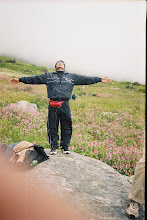Sri Sri: I've spoken quite a bit on Mahavira, Recently we had Mahavira Jayanti also. Mahavir was contemporary of Buddha. Buddha spoke about emptiness, Mahavira spoke about Self. Buddha said there is no self, Mahavira said all that is, is Self. Mahavira never spoke, infact he sat in silence and in His presence people started getting knowledge. So when you are all in silence, know that that is Mahavira's speech and it is ridiculous to talk a lot about silence (laughter).In Jain temples, you have Mahavira, he was 24th tirthankara, last tirthankar and you would find his statue in meditative pose and as soon as you would sit in front of smiling serene figure, you would also become like that. He would tell you how you should sit and with what serenity and just know that you are the Atma the Self and it conveys the whole philosophy.
One of the main things of Mahavira, main principle is 'Syathva' i.e. perhaps. He would always add perhaps in everyone of his expressions. There is room for exploration. If you say, this is like this, you are making it so definite. In this world nothing is definite there is always a possibility, perhaps, that is called 'syathva'. In Physics also the subject object relationship changes, whatever you know, you know in a particular level of consciousness. When your consciousness changes your understanding changes. You can never know 100% unless you become that thing. Its so amazing that Mahavira 2500-2600 years back he came up with 'perhaps' principle, when law of uncertainty, theory of relativity came up in this century, in the previous century perhaps (laughter).
Mahavira's main principle is non-violence ('ahimsa'). You have no right to be violent on anything in the world. Second is 'Swadhyaya'. Study your emotions, your mind, your consciousness. 'Kayothsarga' Rise above your body, you are not the body. Body is changing. 'Tapas' Forbearance, opposites happen in the world, people love you, hate you, people compliment you, you get derogatory remarks. Tapah - forbearance, heat and cold, nature is all conflicting. it has full of opposites. Moving in life with Tapah.
These are the principles of Jainism.And then is 'kShama' - whether knowingly or unknowingly if anything has happened to anyone by acting or not acting you ask for forgiveness. 'Dashlakshini' - 10 days of celebration and prayers in the last day is the 'kShama-achana' - whether with my intentions or unintentions, knowingly or unknowingly, if I have become the cause of any sadness, sorrow for you, please forgive me. Asking for forgiveness, highest principle. Isn't it? When everyone comes from that space of I'm the one responsible for all the experiences pleasant or unpleasant, but if I become the cause of any unpleasant experiences I have ask for forgiveness, ask myself for forgiveness. Its the pinnacle of humility.So the ritual is, every Jain is to ask everyone forgiveness. Please forgive me if I have done anything wrong knowingly or unknowingly. Not only by doing something wrong happens, but by not doing also something wrong happens. Do you see what I'm saying. Suppose you have to do a job and you don't do it, then also you are responsible, you ask for forgiveness. 'kShama-achana' - another principle of Jainism. Hmmm....To ask forgiveness from everyone, mind has to be in such a serene, humble, pleasant state, isn't it? When there is aggression in you, you start justifying yourself, you stop knowing yourself. So they did that space for you to justify yourself. Ask forgiveness. You know that immediately softens the other person's heart also. Someone does something wrong to you and they come and ask forgiveness, would you give them or not? What would you do? When you forgive someone, you become light, you start feeling lighter and all that anger and hatred and that chain of action and reaction drops and you become friendly again. Real virtue is to forgive someone even before they ask for forgiveness. If you don't have that then at least when they ask for forgiveness you have to forgive them. And I don't think you would not, if anyone in spite of pleading for forgiveness, and when you forgive you are the one to benefit. You think you did a great thing, I tell you, you are wrong. When you forgive its you who become free otherwise holding onto that is such a misery. Very good.





.png)

